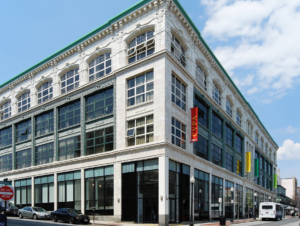
IN 2023, efforts to harness arts and culture as part of New Bedford’s economic revitalization strategy were dealt a blindsiding blow. Two years later, it looks as if all’s well that ends well.
In mid-August of 2023, the University of Massachusetts Dartmouth, whose College of Visual and Performing Arts had occupied a massive 125,000-square-foot building in the heart of the city’s downtown for 22 years, abruptly announced that it was pulling up stakes and moving the program out of the building. The announcement said students would have to vacate studio space in the building by the end of the month – just as the fall semester was beginning.
The school had moved its arts programs into the building – a shuttered department store — under a 20-year lease. During that time, the arts college’s presence in the former Star Store became an important part of the city’s burgeoning arts and culture scene, anchored by the nearby Zeiterion Theater and the New Bedford Whaling Museum.
The university had the option to buy the building for $1 in 2021 when the lease expired. It balked but continued to make monthly rental payments for two years with an annual earmark from the state budget. From there, the story got messy, with lots of finger-pointing over who was to blame for the arts college’s exit.
UMass Dartmouth chancellor Mark Fuller made it clear that the school had no interest in taking ownership of the building. In a letter to the university community, he said the building needed $50 to $75 million in deferred maintenance spending, which made the acquisition “financially impossible.”
For students like Fallon Navarro, who was about to begin the last year of her master’s degree program when the building closed, it was devastating. “It was really hard,” she said. “It was my last year of graduate school, I was a ceramics major, and they were getting rid of everything I needed to get my degree.”
Navarro soldiered through her last year, though the 30-year-old artist, who emerged as a leader of student protests against the building closure, said she probably spent half her time on advocacy work fighting for UMass to reverse course.
That didn’t happen, but prospects for the shuttered building returning to life as a center for arts and culture suddenly seem bright.
Last week, Mayor Jon Mitchell and the New Bedford Economic Development Council announced an agreement to have the former Star Store reopen as a “regional arts hub” under the ownership of the Arts & Business Council of Greater Boston, a nonprofit that acquired the building late last month.
“It’s a real win,” said Tony Sapienza, president of the economic council board.
The building owner, Paul Downey, agreed to sell it to the Boston arts nonprofit for $1 after paying the city about $500,000 to settle a tax lien on the property, according to Mitchell.
The Arts & Business Council acts as a service organization for arts groups. Along with having the financial capacity to take ownership of buildings to preserve them for arts uses, it coordinates other services, such as pro bono legal work through its Volunteer Lawyers for Arts initiative.
But securing property for affordable use by artists is at the center of its work, said Jim Grace, the group’s executive director, who likened it to land trusts established to preserve open space.
Three years ago, the Arts & Business Council bought a 240,000-square-foot former mill building in Lowell with the goal of preserving the affordability of the 300- artist studio and loft living spaces there. It recently acquired and is co-developing with a local arts nonprofit a former YMCA building in the Main South neighborhood of Worcester for artist space.
Grace said the idea of buying property to secure “creative campuses” is driven by the familiar pattern of gentrification that follows when artists bring new vitality to a community. “It gets cool, then they get kicked out. It’s been going on for 40 years,” he said.
Sapienza said a local advisory group will be formed, drawing from city officials, and the local arts and business communities to work with the Arts & Business Council on a vision for the building’s use. It’s likely to include artist studio space as well as first floor gallery and performance space.
After UMass left, the city used federal ARPA funds to commission a study of potential reuses of the building. The report concluded that the cost of converting the building to housing or office space would be prohibitive and that it made the most sense to use it for artist space – given the extensive retrofitting for that purpose that was done decades ago.
The building needs a new roof and HVAC system, which Grace said could cost $5 to $6 million. But the cost of getting it in shape is not nearly as high as UMass officials had said when they waved off interest in staying, said Mitchell. The “figures UMass Dartmouth threw around were way out of the ballpark,” he said.
Mitchell said the turn of events means the building can continue to help fuel the city’s arts and culture sector, which, though dwarfed by sectors like its fishing industry, nonetheless is a vital part of New Bedford’s revitalization strategy, generating about $300 million in annual economic output.
“We have always been committed to the proposition that you have to create a high quality of life to support economic development,” he said. The arts, Mitchell said, are crucial to that.
Those efforts took a big hit with the UMass arts program’s abrupt exit, but it turns out that wasn’t the last chapter.
With the building now poised for revival as arts space, said Mitchell, “It’s a good news story.”
